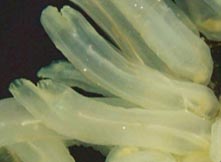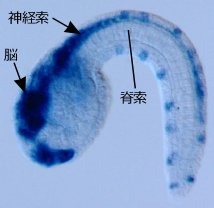They are the closest relatives of vertebrates. Although their adult morphology does not look like us, their tadpole-type larvae represent a simplified mode of the chordate body plan (look at the photo below).

| We use the ascidian Ciona intestinalis. The photo on the right side shows adult individuals. Ascidians are invertebrate chordates. They are the closest relatives of vertebrates. Although their adult morphology does not look like us, their tadpole-type larvae represent a simplified mode of the chordate body plan (look at the photo below). |  |
 | The ascidian larva contains only about 2500 cells. Fertilized eggs develop into swimming larvae within a single day. In their small body, they have the notochord in the center of the tail. They have the neural tube on the dorsal side (arrows in the photo on the left side). These features are characteristic to the chordates. |